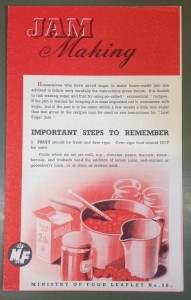Biscuit recipe of the week: 1940s jam biscuits
By Shira Kilgallon, UoR History Student and MERL Library Volunteer
This week’s biscuit recipe comes from Ministry of Food pamphlets found in the MERL Library collections; two pamphlets have been used to give you a recipe with a twist (and a bit of a challenge!!).
This particular twist is definitely for the more experimental among both biscuit enthusiasts and beginners, as the recipe not only gives a fairly conventional and simple biscuit recipe, but also instructs how to make the jam from scratch. The recipe itself is fairly straightforward, but a little more complicated than previous weeks.
Both pamphlets are from the late 1940s post-war era. They thus contain, as you may find in any recipe books or pamphlets of the time, some rather misogynistic top tips for the ‘contemporary housewife’, which I’m sure you’ll be pleased to see have not been forgotten below! It is also interesting to note that the biscuit recipe was written with the intention of, as the title suggests, ‘Making the most of sugar’ when it was scarcely available due to rationing.
We hope this week’s biscuit recipe will inspire you through its challenging nature – or even its simplicity if you choose to just buy a jar of jam…
Making the most of the sugar
(from Ministry of Food Leaflet No. 21, Dec. 1946, MERL Library Pamphlets 7060 BOX 2/04)
The best way of stretching the sugar ration is by making full use of other sweetenings such as saccharin, honey, syrup or treacle, jam, marmalade, sweetened condensed milk and dried fruit.
Using Jam and Marmalade
Rinse empty jam jars with a little hot water and use this in sauces or for mixing puddings and cakes.
Jam Biscuits
3 oz. fat 8 oz. flour 2 tablespoons milk 3 tablespoons jam
Rub fat into flour till the consistency of breadcrumbs. Mix together the milk and the jam. Add this to the fat and flour, knead well. Roll out very thinly, cut in shapes and bake in a moderate oven for 15 minutes.
(All spoons are level and all recipes for four.)
(from Ministry of Food Leaflet No. 28, 1946, MERL Library Pamphlets 7060 BOX 2/31)
Housewives who have saved sugar to make home-made jam are advised to follow very carefully the instructions given below.
- Fruit should be fresh and firm-ripe. Over-ripe fruit should NOT be used.
- Before the sugar is added, the fruit should be cooked slowly until it is quite tender, with just sufficient water to prevent it burning. Stir occasionally to prevent sticking.
- SUGAR is stirred into the softened fruit until dissolved and the jam then boiled rapidly until setting point is reached. Do not have the pan too full or the jam will boil over at this stage. Stir occasionally to prevent sticking.
- Removing Scum. Do this only when boiling has finished. Constant skimming is wasteful and unnecessary.
- Testing for setting point. Begin to test after about 10 minutes of rapid boiling (after sugar has been added). Remove pan from heat during testing.
To test: place a little jam on a cold plate; if setting point has been reached, the jam will wrinkle when pushed with a finger.
- Filling the Jars. To prevent fruit rising in the jars, the jam should be allowed to cool slightly in the pan.
Put on wax disks while hot, and press down over the surface.
From the various types of jam recipes outlined in the recipe leaflet, we chose:
Raspberry Jam
6lb. raspberries 6lb. sugar
Put the fruit in the pan and cook slowly until some juice has come out of the fruit. Add the sugar, stir until it is dissolved, and boil rapidly until setting point is reached.
Please try out the recipes and don’t forget to enter the MERL Village Fete Biscuit Bake-Off on 31 May!


